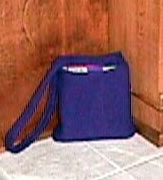|
|
The purse is knit from side to side in stockinette. That means you can easily knit vertical stripes by changing colors every few rows. Mine is purple, and is currently holding a box of Tender Vittles cat food to show its shape and size. You can't see it in the picture, but the straps and top of purse curl. The top curls slightly, forming a nice edge. The straps curl a lot; you can press this out with an iron leaving only a slight inward curl. I didn't press it out because I like the curl. If you hate curling, you can apply some sort of edge treatment.
My purse is knit in Jagger Spun 2/8 wool, in royal purple, then felted by throwing it in the washing machine with a load of whites. I used hot water. You can knit yours in any wool that felts; most 100% animal fibers do. I used about 2 ounces to make a 8" tall, 7" wide, 2" deep purse with 26" straps. If you are using worsted weight yarn, budget about 4 ounces for a purse of this size. If you make it twice as tall or twice as wide, you'll need twice as much yarn as for a purse this size. If you make it twice as tall and twice as wide, you'll need 4 times the yarn!
Can you knit this by hand? Yes. However, you will need to understand the directions and adapt them to hand knitting. I've tried writing directions simultaneously in MK and HK, but it seems to confuse people. So, I'm not trying any more! (Anyway, there is a much more efficient way HK a purse this shape. Visit the white purse page to see the HK version. )
Good luck,
Lucia
